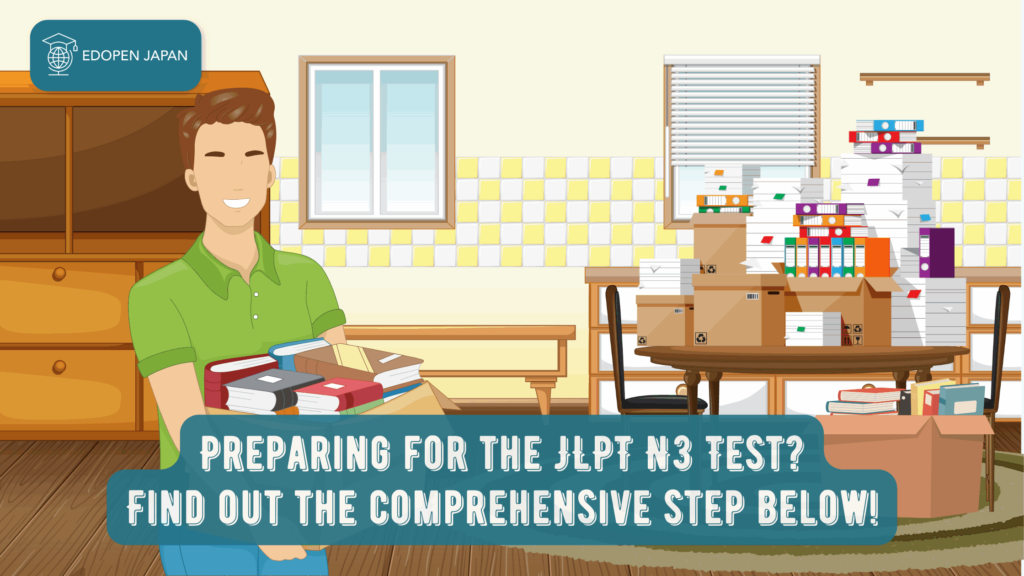Are you preparing for the JLPT exam? Did you know that JLPT level N3 is the intermediate level that many foreigners who want to build a career in various fields in Japan are aiming for?
For example, for engineers who want to work in Japanese companies, the JLPT N3 certificate is the most basic and very important requirement.
Then, there are various aspects that are tested in the JLPT N3 exam, one of which is Kanji knowledge. To pass the JLPT N3 level, you need to know at least 650 kanji. And here we discuss the 100 most important kanji for JLPT level N3.
By mastering these 100 N3 kanji, your chances of passing the JLPT N3 exam will increase! Please read and study the following 100 essential kanji for JLPT Level N3 carefully!
To pass the JLPT N3 exam, it’s crucial to not just strengthen your exam preparation but also master the JLPT N3 vocabulary, which comprises about 3,750 words. Click the button below to access the JLPT N3 vocabulary list and supplement your studying.
Read also:
10 Most Powerful & Popular Textbooks to Pass JLPT N3
JLPT: A Complete Guide to the Differences Between Levels N1-N5
Apply for JLPT N3 (2023)

Before delving into the 100 most crucial kanji for the JLPT N3, it is essential to review a concise outline of the JLPT N3 application and examination process.
Please note that each session is held twice a year in early July and December. The JLPT is typically administered biannually, specifically during the initial Sunday of July and December.
Taking JLPT N3 in Japan
- Release dates of test information: (First test) around early February and (Second test) around early July.
- Registration period (online only): (First test) from late March to mid-April and (Second test) from late August to mid-September.
- Receipt of paper test voucher: (First test) mid-June and (Second test) mid-November.
- Publication of test results: (First test) in early September and (Second test) in early February.
- Exam Fee: 6,500 JPY (including excise tax).
The application is online-only, therefore, make sure you register and sign on at MyJLPT on JEES website: https://info.jees-jlpt.jp/info/
| All Levels | Test Date | Registration | Test Voucher | Test Results |
|---|---|---|---|---|
| First test | Sunday, July 2 | March ~ April | June | the end of August 2023 |
| Second test | Sunday, December 3 | August ~ September | November | the end of January 2024 |
Taking in the United States
Test Fee: $100
The Japanese Language Proficiency Test (JLPT) in the United States is administered by the American Association of Teachers of Japanese (AATJ). Please note that there is no July test available in the United States. For the latest registration information, please visit: https://www.aatj.org/jlpt.
| N3 | Test Date | Registration | Test Results |
|---|---|---|---|
| First test | – | – | – |
| Second test | December 3 | From August until September | around March 2024 |
Taking in other countries or areas
- Some countries/cities only held one exam (July or December) each year.
- Depending on the country, there are different application deadlines and the date of the result.
- Check this page for the region where you want to take JLPT: https://www.jlpt.jp/e/application/overseas_list.html
Due to the spread of COVID-19, please visit the official JLPT website for the most up-to-date information.
Preparing for the JLPT N3 Test

Take note: The duration of the test and the required passing score for N3 differs from those of N4 and N5. As depicted in the table below, the examination duration is longer in all three sections.
Though the pass mark for each section may seem low, the overall pass mark is 95, with a pass mark of 90 in both N4 and N5.
◉ Linguistic competence required: The ability to understand Japanese used in everyday situations to a certain degree.
◉ Overall pass marks / full marks: 95 / 180 points.
◉ All questions are multiple-choice questions. No essay question.
In all the levels, the main test sections include: Language Knowledge(Vocabulary / Grammar): 言語知識(文字・語彙 / 文法), reading: 読解 and listening: 聴解.
| N3 Test sections | Language Knowledge (Vocabulary / Grammar)・Reading | Listening |
|---|---|---|
| Test time | Language Knowledge (Vocabulary): 30 min Language Knowledge (Grammar)・Reading: 70 min | 40 min |
| Sectional pass mark / full mark | Language Knowledge (Vocabulary / Grammar): 19 / 60 points Reading: 19 / 60 points | 19/60 points |
Section 1: Language Knowledge (Vocabulary):
| ✎ Kanji reading | Select the correct hiragana for the kanji word given in the question. |
| ✎ Orthography | Select the correct kanji for the hiragana given in the question. |
| ✎ Contextually-defined expressions | Select the most proper word/phrase to complete the given sentence in the question. |
| ✎ Paraphrases | Select the option that possesses the closest meaning to the given sentence in the question. |
| ✎ Usages | Select the correct usage(sentence) of the given word in the question. |
For N3 examinees, recognizing hiragana and katakana should not be an issue. However, as you progress to the upper levels, increasing your Japanese vocabulary for JLPT N3 becomes a critical mission.
According to some test-takers, aside from acquiring new vocabulary, correctly pronouncing specific words presents another challenge.
- We all know that the pronunciation of words with “k or g”, “s or z”, and “t or d” can sound similar to each other. In daily life, the wrong pronunciation won’t be a big matter in the conversation. However, this can be confusing when taking tests.
For example:
“観客“, “かんきゃく“? Or “かんぎゃく“?
- Is this word with “う”(u) behind? Is this word with “っ”(small tsu) in the middle? This is also one of the challenges occur in this section.
For example:
“到着“, is it “とうちゃく“? Or “とちゃく“?
“欠席“, is it “けっせき“? Or “けせき“?
Section 2: Language Knowledge (Grammar)・Reading
Language Knowledge (Grammar)
| ✎ Sentential grammar 1 (Selecting grammar form) | Select the correct phrase that can best fit into the question. |
| ✎ Sentential grammar 2 (Sentence composition) | There are 4 consecutive spaces in a sentence. You must construct the sentence with the 4 given options and choose the correct option for the assign space. |
| ✎ Text grammar | Select the correct word/particle that can best fit into the blank in an article. |
Reading
| ✎ Comprehension (Short passages) | Choose the correct option to the question according to the given passages. |
| ✎ Comprehension (Mid-size passages) | Choose the correct option to the question according to the given passages (mid-size). |
| ✎ Comprehension (Long passages) | Choose the correct option to the question according to the given passages (long-size). |
| ✎ Information retrieval | You might be given graphs, tables, or any data in other forms, which you need to find the answer to the questions. |
After studying N3 grammar, you may have found the new grammar in N4 and N5 more complex. There are several grammatical structures that have similar meanings, but their correct usage can be quite distinct from each other.
As you work through the exercise book, monitor your reading time for the reading section. If you find yourself spending too much time reading, work on improving your reading speed before the exam.
Section 3: Listening
| ✎ Task-based comprehension | Exam sheet: (○) options & (X) question The description of the situation and question will be played, then followed by a conversation. Lastly, the question will be played again. |
| ✎ Comprehension of key points | Exam sheet: (○) options & (X) question The question will be played. Before the statement/conversation being played, there’s a short pause to read the options. Lastly, the question will be played again. |
| ✎ Comprehension of general outline | Exam sheet: (X) options & (X) question Firstly, the description of the situation will be played, then followed by a conversation. Lastly, the question and the options will be played only once. |
| ✎ Verbal expressions | Exam sheet: (X) options & (X) question The pictures are given in your exam paper, and a person is pointed with an arrow. Choose the best option that the person could say according to the picture. The options are played only once. |
| ✎ Quick response | Exam sheet: (X) options & (X) question Listen to a statement and the options. Choose from the option that can be the best reply to the statement. |
100 Kanji list of JLPT N3

| Kanji 漢字 | Onyomi 音読み | Kunyomi 訓読み | Word 語彙 | Hiragana | English |
|---|---|---|---|---|---|
| 繰 | ー | く | 繰り返す | く-り-かえ-す | to repeat |
| 宛 | ー | あて | 宛先 | あて-さき | the address to be delivered |
| 桁 | ー | けた | 4桁 | よん-けた | 4 digit number |
| 移 | イ | うつ | ・移民 ・移す | ・い-みん ・うつ-す | ・immigrant, to immigrate ・to move, transfer |
| 囲 | イ | かこ | ・範囲 ・囲む | ・はん-い ・かこ-む | ・a range ・to surround / circle |
| 隠 | イン | かく | 隠す | かく-す | to hide, conceal |
| 援 | エン | ー | 応援 | おう-えん | to support/cheer for somebody |
| 煙 | エン | けむ・ けむり | 禁煙 | きん-えん | No smoking. |
| 演 | エン | ー | 演奏 | えん-そう | musical performace, to play a musical instrument |
| 殴 | オウ | なぐ | 殴る | なぐ-る | to hit, punch, strike |
| 温 | オン | あたた・ ぬる | ・温度 ・温める | ・おん-ど ・あたた-める | ・temperature ・to heat up |
| 悔 | カイ | く・くや | 悔しい | くや-しい | being regratable, frustrated |
| 解 | カイ・ ゲ | と | ・理解 ・解ける | ・り-かい ・と-ける | ・understanding, comprehension ・to be resolved |
| 確 | カク | たし | ・確認 ・確かめる | ・かく-にん ・たし-かめる | ・to check ・to verify |
| 覚 | カク | おぼ・さ | 覚める | さ-める | to awake |
| 顎 | ガク | あご | 顎 | あご | jaw |
| 巻 | カン | ま | ・3巻 ・巻く | ・さん-かん ・ま-く | ・three volumes ・to roll up, wind, wrap |
| 刊 | カン | ー | 夕刊 | ゆう-かん | evening newspaper |
| 乾 | カン | かわ | ・乾燥 ・乾く | ・かん-そう ・かわ-く | ・being dry ・to get dry |
| 寄 | キ | よ | 寄る | よ-る | to get closer, get together |
| 基 | キ | もと | 基本的 | き-ほん-てき | fundamental, basic |
| 記 | キ | しる | 記事 | き-じ | article |
| 許 | キョ | ゆる | ・免許 ・許す | ・めん-きょ ・ゆる-す | ・licence, permission ・to forgive, allow |
| 叫 | キョウ | さけ | 叫ぶ | さけ-ぶ | to shout out, scream, yell |
| 曲 | キョク | ま | 曲がる | ま-がる | to bend, turn |
| 禁 | キン | ー | 禁止 | きん-し | prohibition, to prohibit |
| 警 | ケイ | ー | 警察 | けい-さつ | a police |
| 激 | ゲキ | はげ | ・激安 ・激しい | ・げき-やす ・はげ-しい | ・bargain-priced, extremely cheap ・being intense, in an extreme degree |
| 穴 | ケツ | あな | 穴 | あな | hole |
| 現 | ゲン | あらわ | ・現実 ・現す | ・げん-じつ ・あらわ-す | ・reality ・to appear, indicate, show |
| 建 | ケン・ コン | た | 建てる | た-てる | to build (building/house…) |
| 誤 | ゴ | あやま | ・誤字 ・誤り | ・ご-じ ・あやま-り | ・a typo ・a mistake |
| 慌 | コウ | あわ | 慌てる | あわ-てる | to panic |
| 叩 | コウ | たた・ はた・ひか | 叩く | たた-く | to knock(door) / hit / tap |
| 広 | コウ | ひろ | ・広げる ・広い | ・ひろ-げる ・ひろ-い | ・to extend, broaden ・being wide, broad, large |
| 効 | コウ | き | ・効果 ・効く | ・こう-か ・き-く | ・effect, effectiveness ・to be effective |
| 混 | コン | ま・こ | ・混乱 ・混ぜる | ・こん-らん ・ま-ぜる | ・disorder, chaos, mix-up ・to mix something and another |
| 祭 | サイ | まつ | 祭り | まつ-り | a festival |
| 作 | サク・ サ | つく | ・作品 ・作業 | ・さく-ひん ・さ-ぎょう | ・creation / a peice of work ・work |
| 殺 | サツ・ サイ | ころ | 殺す | ころ-す | to kill |
| 賛 | サン | ー | 賛成 | さん-せい | to agree with |
| 脂 | シ | あぶら | 動物性脂肪 | どう-ぶつ-せい-し-ぼう | ・animal fat |
| 刺 | シ | さ | ・名刺 ・刺す | ・めい-し ・さ-す | ・a business card ・to stick / stab / be bitten(by mosquito) |
| 辞 | ジ | や | 辞める | や-める | to quite, give up (job, doing something) |
| 湿 | シツ | しめ | ・湿度 ・湿る | ・しつ-ど ・しめ-る | ・Humidity ・to be wet |
| 奢 | シャ | おご | 奢る | おご-る | to give (someone) a treat |
| 斜 | シャ | なな | 斜め | なな-め | being at a slant, oblique |
| 蹴 | シュウ | け | 蹴る | け-る | to kick |
| 重 | ジュウ・ チョウ | え・ おも・かさ | ・重量 ・重ねる | ・じゅう-りょう ・かさ-ねる | ・weight of something ・to pile up, to repeat many times |
| 渋 | ジュウ・ チョウ | しぶ | ・渋滞 ・渋谷 | ・じゅう-たい ・しぶ-や | ・traffic jam ・Shibuya (Tokyo) |
| 巡 | ジュン | めぐ | ・巡回 ・寺巡り | ・じゅん-かい ・てら-めぐ-り | ・go round, on patrol ・visit temples from place to place |
| 順 | ジュン | ー | 順番 | じゅん-ばん | do something in sequence |
| 招 | ショウ | まね | 招き猫 | まね-き-ねこ | the cat brings luck |
| 唇 | シン | くちびる | 唇 | くちびる | lip |
| 申 | シン | もう | ・申請 ・申し込む | ・しん-せい ・もう-し-こ-む | ・application, to apply ・to apply |
| 伸 | シン | の | 伸びる | の-びる | (height)to get taller, (hair)to get longer, to get longer, stretch |
| 製 | セイ | ー | 製品 | せい-ひん | product |
| 節 | セツ・ セチ | ふし | 節約 | せつ-やく | the saving of (resources, expense…) |
| 浅 | セン | あさ | 浅い | あさ-い | being shallow, light |
| 羨 | セン | うらや | 羨ましい | うらや-ましい | be jealous |
| 争 | ソウ | あらそ | ・戦争 ・争う | ・せん-そう ・あらそ-う | ・war ・to contend/argue |
| 掻 | ソウ | か | 掻く | か-く | to scratch |
| 騒 | ソウ | さわ | ・騒音 ・騒ぐ | ・そう-おん ・さわ-ぐ | ・noise, undesired sound ・to be noisy, to make a clamor |
| 噂 | ソン | うわさ | 噂 | うわさ | rumour |
| 詫 | タ | わ・わび・ほこ | お詫び | お-わ-び | an apology |
| 暖 | ダン | あたた | 暖まる | あたた-まる | to get warm |
| 仲 | チュウ | なか | 仲間 | なか-ま | companion, fellow |
| 賃 | チン | ー | 家賃 | や-ちん | house rent |
| 燃 | ネン | も | ・可燃ゴミ ・燃える | ・か-ねん-ごみ ・も-える | ・combustible waste ・being flammable |
| 農 | ノウ | ー | 農家 | のう-か | farmer |
| 破 | ハ | やぶ | 破る | やぶ-る | to breake, destroy |
| 黴 | バイ・ビ・ミ | カビ・か | 防黴剤 | ぼう-かび-ざい | mildewproofing agent |
| 抜 | バツ | ぬ | 抜く | ぬ-く | to take away, exclude |
| 坂 | ハン | さか | 上り坂 | のぼ-り-さか | an uphill road |
| 避 | ヒ | さ | 避ける | さ-ける | to avoid |
| 表 | ヒョウ | おもて・ あらわ | ・時刻表 ・表す | ・じ-こく-ひょう ・あらわ-す | ・a time table ・to express/symbolize/represent |
| 腐 | フ | くさ | 腐る | くさ-る | something(food…) go bad |
| 幅 | フク | はば | 幅広い | はば-ひろ-い | a wide range of |
| 癖 | ヘキ | くせ | 悪い癖 | わる-い-くせ | a bad habit |
| 騙 | ヘン | かた・だま | 騙す | だま-す | to deceive |
| 暮 | ボ | く | 暮らす | く-らす | to live |
| 縫 | ホウ | ぬ | 縫う | ぬ-う | to sew |
| 飽 | ホウ | あ | 飽きる | あ-きる | to get tired of |
| 豊 | ホウ | ゆた | 豊か | ゆた-か | being abundant, prosperous (future…), fertile (imagination) |
| 訪 | ホウ | おとず・ たず | ・訪問販売 ・訪ねる | ・ほう-もん-はん-ばい ・たず-ねる | ・door-to-door selling ・to visit somewhere |
| 防 | ボウ | ふせ | ・防犯カメラ ・防ぐ | ・ぼう-はん-かめら ・ふせ-ぐ | ・security camera ・to prevent |
| 望 | ボウ・ モウ | のぞ | ・希望 ・望む | ・き-ぼう ・のぞ-む | ・(to) wish, request ・to hope, wish |
| 埋 | マイ | う | 埋まる | う-まる | to cover, fill in, bury |
| 満 | マン | み | ・満足 ・満たす | ・まん-ぞく ・み-たす | ・being satisfied ・to satisfy |
| 夢 | ム | ゆめ | ・夢中 ・夢 | ・む-ちゅう ・ゆめ | ・being addicted to ・dream |
| 預 | ヨ | あず | ・預かる ・預ける | ・あず-かる ・あず-ける | ・to look after, take care of, keep ・to deposit, leave something in somebody’s care |
| 与 | ヨ | あた | ・給与 ・与える | ・きゅう-よ ・あた-える | ・salary ・to give |
| 揺 | ヨウ | ゆ | 揺れる | ゆ-れる | to swing, shake |
| 揚 | ヨウ | あ | 揚げる | あ-げる | to fry |
| 痒 | ヨウ | かゆ・ かさ・や・やまい | 痒い | かゆ-い | itchy |
| 乱 | ラン | みだ | ・乱暴 ・乱れる | ・らん-ぼう ・みだ-れる | ・violence ・to be in disorder |
| 流 | リュウ・ ル | なが | ・一流 ・流れ | ・いち-りゅう ・なが-れ | ・the best, top-ranking (resterant, school…) ・a stream, a processing flow |
| 齢 | レイ | ー | 年齢 | ねん-れい | age |
| 礼 | レイ・ ライ | ー | 礼儀 | れい-ぎ | courtesy |
| 連 | レン | つら・つ | 連続 | れん-ぞく | consecutively |
| Kanji 漢字 | Onyomi 音読み | Kunyomi 訓読み | Word 語彙 | Hiragana | English |
Quick Link for JLPT N3 Preparation
- JLPT Offical Site: https://www.jlpt.jp/e/index.html
- JLPT-Sample Questions: https://www.jlpt.jp/e/samples/forlearners.html
- JLPT-Composition of Test Sections and Items: https://www.jlpt.jp/e/guideline/testsections.html
- JEES website (For application): https://info.jees-jlpt.jp/
- American Association of Teachers of Japanese(全米日本語教育学会): https://www.aatj.org/jlpt-us
Summary
Preparing for an exam is challenging indeed. It’s not just about acquiring new vocabulary and grammatical concepts, but also ensuring that you are relaxed while taking the test and that you have enough time to complete it. Therefore, it’s essential to prepare yourself mentally and physically for the exam.
Lastly, we hope that the Kanji list and N3 information will prove helpful. PDF and Excel files to download the 100 kanji list for JLPT N3 are provided below.












